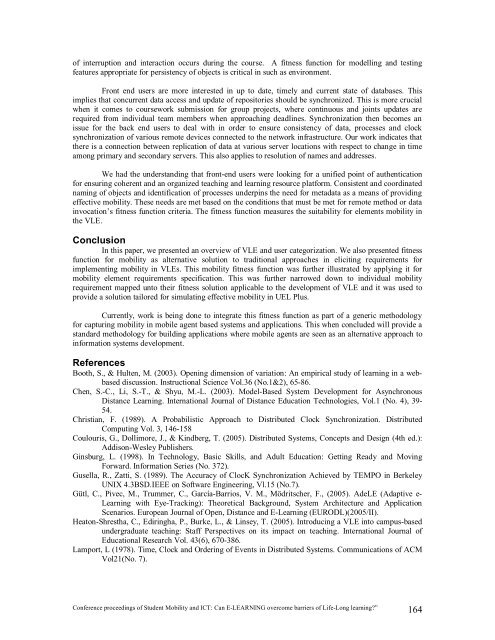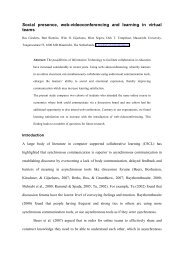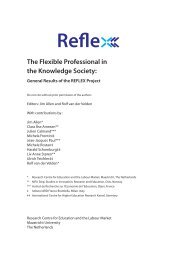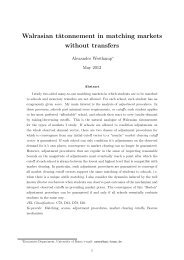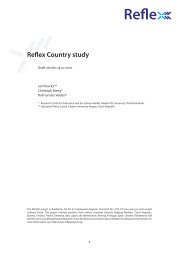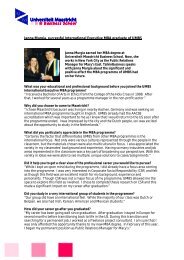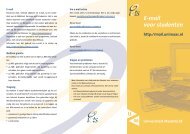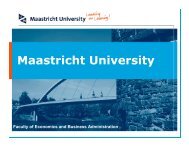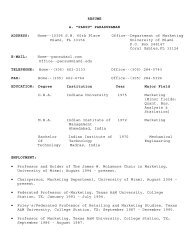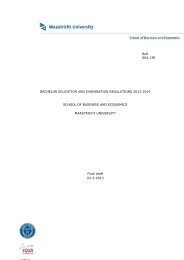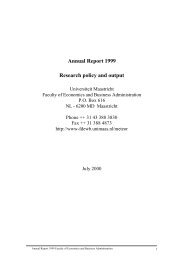proceedings of Student Mobility and ICT: Can E-LEARNING
proceedings of Student Mobility and ICT: Can E-LEARNING
proceedings of Student Mobility and ICT: Can E-LEARNING
Create successful ePaper yourself
Turn your PDF publications into a flip-book with our unique Google optimized e-Paper software.
<strong>of</strong> interruption <strong>and</strong> interaction occurs during the course. A fitness function for modelling <strong>and</strong> testing<br />
features appropriate for persistency <strong>of</strong> objects is critical in such as environment.<br />
Front end users are more interested in up to date, timely <strong>and</strong> current state <strong>of</strong> databases. This<br />
implies that concurrent data access <strong>and</strong> update <strong>of</strong> repositories should be synchronized. This is more crucial<br />
when it comes to coursework submission for group projects, where continuous <strong>and</strong> joints updates are<br />
required from individual team members when approaching deadlines. Synchronization then becomes an<br />
issue for the back end users to deal with in order to ensure consistency <strong>of</strong> data, processes <strong>and</strong> clock<br />
synchronization <strong>of</strong> various remote devices connected to the network infrastructure. Our work indicates that<br />
there is a connection between replication <strong>of</strong> data at various server locations with respect to change in time<br />
among primary <strong>and</strong> secondary servers. This also applies to resolution <strong>of</strong> names <strong>and</strong> addresses.<br />
We had the underst<strong>and</strong>ing that front-end users were looking for a unified point <strong>of</strong> authentication<br />
for ensuring coherent <strong>and</strong> an organized teaching <strong>and</strong> learning resource platform. Consistent <strong>and</strong> coordinated<br />
naming <strong>of</strong> objects <strong>and</strong> identification <strong>of</strong> processes underpins the need for metadata as a means <strong>of</strong> providing<br />
effective mobility. These needs are met based on the conditions that must be met for remote method or data<br />
invocation’s fitness function criteria. The fitness function measures the suitability for elements mobility in<br />
the VLE.<br />
Conclusion<br />
In this paper, we presented an overview <strong>of</strong> VLE <strong>and</strong> user categorization. We also presented fitness<br />
function for mobility as alternative solution to traditional approaches in eliciting requirements for<br />
implementing mobility in VLEs. This mobility fitness function was further illustrated by applying it for<br />
mobility element requirements specification. This was further narrowed down to individual mobility<br />
requirement mapped unto their fitness solution applicable to the development <strong>of</strong> VLE <strong>and</strong> it was used to<br />
provide a solution tailored for simulating effective mobility in UEL Plus.<br />
Currently, work is being done to integrate this fitness function as part <strong>of</strong> a generic methodology<br />
for capturing mobility in mobile agent based systems <strong>and</strong> applications. This when concluded will provide a<br />
st<strong>and</strong>ard methodology for building applications where mobile agents are seen as an alternative approach to<br />
information systems development.<br />
References<br />
Booth, S., & Hulten, M. (2003). Opening dimension <strong>of</strong> variation: An empirical study <strong>of</strong> learning in a webbased<br />
discussion. Instructional Science Vol.36 (No.1&2), 65-86.<br />
Chen, S.-C., Li, S.-T., & Shyu, M.-L. (2003). Model-Based System Development for Asynchronous<br />
Distance Learning. International Journal <strong>of</strong> Distance Education Technologies, Vol.1 (No. 4), 39-<br />
54.<br />
Christian, F. (1989). A Probabilistic Approach to Distributed Clock Synchronization. Distributed<br />
Computing Vol. 3, 146-158<br />
Coulouris, G., Dollimore, J., & Kindberg, T. (2005). Distributed Systems, Concepts <strong>and</strong> Design (4th ed.):<br />
Addison-Wesley Publishers.<br />
Ginsburg, L. (1998). In Technology, Basic Skills, <strong>and</strong> Adult Education: Getting Ready <strong>and</strong> Moving<br />
Forward. Information Series (No. 372).<br />
Gusella, R., Zatti, S. (1989). The Accuracy <strong>of</strong> ClocK Synchronization Achieved by TEMPO in Berkeley<br />
UNIX 4.3BSD.IEEE on S<strong>of</strong>tware Engineering, Vl.15 (No.7).<br />
Gütl, C., Pivec, M., Trummer, C., García-Barrios, V. M., Mödritscher, F., (2005). AdeLE (Adaptive e-<br />
Learning with Eye-Tracking): Theoretical Background, System Architecture <strong>and</strong> Application<br />
Scenarios. European Journal <strong>of</strong> Open, Distance <strong>and</strong> E-Learning (EURODL)(2005/II).<br />
Heaton-Shrestha, C., Ediringha, P., Burke, L., & Linsey, T. (2005). Introducing a VLE into campus-based<br />
undergraduate teaching: Staff Perspectives on its impact on teaching. International Journal <strong>of</strong><br />
Educational Research Vol. 43(6), 670-386.<br />
Lamport, L (1978). Time, Clock <strong>and</strong> Ordering <strong>of</strong> Events in Distributed Systems. Communications <strong>of</strong> ACM<br />
Vol21(No. 7).<br />
Conference <strong>proceedings</strong> <strong>of</strong> <strong>Student</strong> <strong>Mobility</strong> <strong>and</strong> <strong>ICT</strong>: <strong>Can</strong> E-<strong>LEARNING</strong> overcome barriers <strong>of</strong> Life-Long learning?” 164


